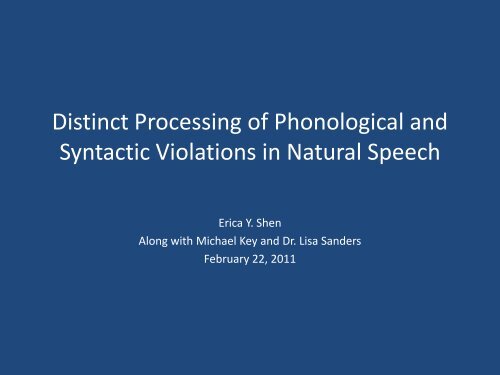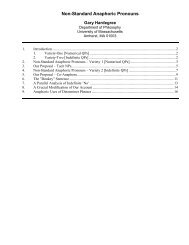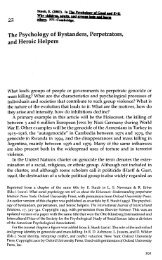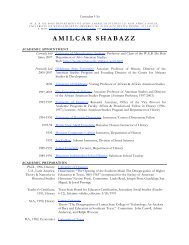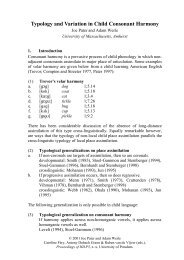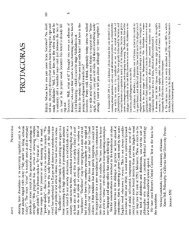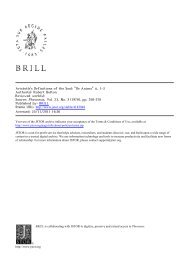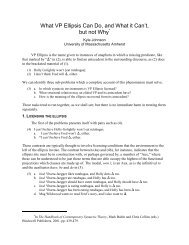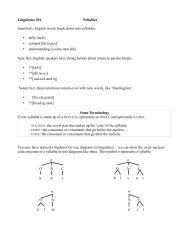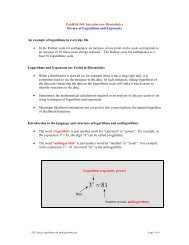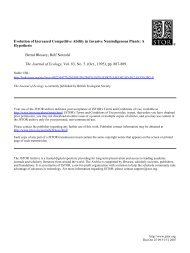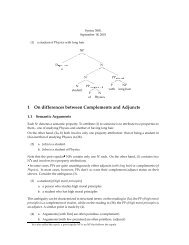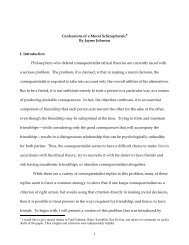Distinct Processing of Phonological and Syntactic Violations in ...
Distinct Processing of Phonological and Syntactic Violations in ...
Distinct Processing of Phonological and Syntactic Violations in ...
Create successful ePaper yourself
Turn your PDF publications into a flip-book with our unique Google optimized e-Paper software.
<strong>Dist<strong>in</strong>ct</strong> <strong>Process<strong>in</strong>g</strong> <strong>of</strong> <strong>Phonological</strong> <strong>and</strong><br />
<strong>Syntactic</strong> <strong>Violations</strong> <strong>in</strong> Natural Speech<br />
Erica Y. Shen<br />
Along with Michael Key <strong>and</strong> Dr. Lisa S<strong>and</strong>ers<br />
February 22, 2011
<strong>Phonological</strong> process<strong>in</strong>g vs.<br />
<strong>Syntactic</strong> process<strong>in</strong>g<br />
Specific language impairment (SLI)<br />
7.4% <strong>of</strong> monol<strong>in</strong>guistic k<strong>in</strong>dergarteners have SLI<br />
No <strong>in</strong>telligence or hear<strong>in</strong>g deficits<br />
Delayed language development<br />
Difficulties <strong>in</strong> produc<strong>in</strong>g <strong>and</strong> comprehend<strong>in</strong>g<br />
morphologically complex words (Joanisse &<br />
Seidenberg, 1998)<br />
The past tense <strong>and</strong> plural <strong>in</strong>flections <strong>in</strong> English (e.g., baked,<br />
books)<br />
Can underst<strong>and</strong> the concepts <strong>of</strong> past tense <strong>and</strong> plurality,<br />
but have impaired ability to express these concepts
<strong>Phonological</strong> process<strong>in</strong>g vs.<br />
<strong>Syntactic</strong> process<strong>in</strong>g<br />
Two Theories for SLI<br />
Inability to learn <strong>in</strong>flectional rules<br />
Can only learn morphonological mark<strong>in</strong>g through mechanical<br />
learn<strong>in</strong>g <strong>of</strong> <strong>in</strong>dividual <strong>in</strong>flected words<br />
E.g., baked, took vs. wug<br />
<strong>Phonological</strong> Deficits<br />
Impaired speech perception affects phonological<br />
representation development affects grammatical<br />
development<br />
Abnormal phonology, difficulty <strong>in</strong> identify<strong>in</strong>g words<br />
conta<strong>in</strong><strong>in</strong>g similar phonemes, misarticulation or deletion <strong>of</strong><br />
phonemes from words, poor phonological awareness
<strong>Phonological</strong> process<strong>in</strong>g vs.<br />
<strong>Syntactic</strong> process<strong>in</strong>g<br />
Developmental dyslexia<br />
E.g., gave, save; m<strong>in</strong>t, h<strong>in</strong>t w/ exceptions such as have & p<strong>in</strong>t,<br />
then, how should mave be pronounced?<br />
Failure to develop segmental phonological representations<br />
Prevents learn<strong>in</strong>g <strong>of</strong> correct<br />
spell<strong>in</strong>g <strong>and</strong> sound correspondences<br />
SLI & developmental dyslexia<br />
Impaired phonology usage<br />
impaired l<strong>in</strong>guistic regularity acquisition
<strong>Phonological</strong> process<strong>in</strong>g vs.<br />
<strong>Syntactic</strong> process<strong>in</strong>g<br />
Important for underst<strong>and</strong><strong>in</strong>g language<br />
process<strong>in</strong>g as well as a broad range <strong>of</strong><br />
language process<strong>in</strong>g deficits.
Morphophonological <strong>Violations</strong><br />
Inflectional morphemes are word-‐f<strong>in</strong>al <strong>and</strong><br />
unstressed <strong>in</strong> English.<br />
The impaired use <strong>of</strong> these morphemes reflects<br />
(1) their grammatical status?<br />
(2) their lack <strong>of</strong> perceptual salience?
The rule govern<strong>in</strong>g past tense formation <strong>in</strong><br />
English:<br />
Morphophonological <strong>Violations</strong><br />
If the f<strong>in</strong>al phoneme <strong>of</strong> a present tense verb is<br />
a voiceless consonant add /t/<br />
a voiced consonant or a vowel add /d/<br />
an alveolar stop (/t/ or /d/) add /id/<br />
Morphological rules conta<strong>in</strong> phonological components<br />
Three allomorphs <strong>of</strong> the English past tense morpheme<br />
which form is appropriate?<br />
depends on the f<strong>in</strong>al phoneme <strong>of</strong> the root stem
Morphosyntactic <strong>Violations</strong>
Left Anterior Negativity<br />
Left Anterior Negativity<br />
Elicited by morphosyntactic<br />
violations<br />
(SS) The key is <br />
(SP) The key are <br />
Early, Automatic
P600<br />
P600<br />
Reflects syntactic ambiguity &<br />
complexity<br />
Reflects a more controlled<br />
process<br />
Larger when do<strong>in</strong>g a<br />
grammaticality judgment task
Other ERP Indices
N400<br />
N400<br />
Elicits a posterior negativity<br />
(N400) 300-‐500 ms<br />
(Canonical) She turns <strong>of</strong>f the light.<br />
(Violation) She turns <strong>of</strong>f the cloud.
PMN<br />
PMN<br />
<strong>Phonological</strong> mismatch<br />
negativity (PMN), reflect<strong>in</strong>g<br />
a discrepancy between the<br />
<strong>in</strong>itial phonemes <strong>of</strong> the<br />
expected word <strong>and</strong> the<br />
actually perceived word<br />
Fully congruent<br />
She had a streak <strong>of</strong> bad luck.<br />
Initially congruent<br />
She had a streak <strong>of</strong> bad luggage.<br />
Fully <strong>in</strong>congruent<br />
She had a streak <strong>of</strong> bad baggage.
Natural Speech Stimuli<br />
Current Study<br />
Stimuli are four short stories<br />
Low proportion <strong>of</strong> violations<br />
Listen<strong>in</strong>g for comprehension only<br />
<strong>Phonological</strong> vs. <strong>Syntactic</strong><br />
Allomophic violations<br />
Inflectional morphemes rema<strong>in</strong> <strong>in</strong>tact<br />
Inclusion <strong>of</strong> syntactic violations for direct comparison
ERP<br />
Current Study<br />
Excellent temporal resolution<br />
-‐ A result <strong>of</strong> time-‐lock<strong>in</strong>g to a specific event<br />
Does not require secondary tasks<br />
-‐ Ideal for study<strong>in</strong>g receptive language process<strong>in</strong>g<br />
<strong>Dist<strong>in</strong>ct</strong> ERP <strong>in</strong>dices<br />
-‐ Differentiate phonological process<strong>in</strong>g from syntactic <strong>and</strong><br />
semantic process<strong>in</strong>g
Research Questions<br />
Can people detect phonological violations under<br />
ecologically valid test<strong>in</strong>g conditions?<br />
-‐ In the behavioral experiment?<br />
-‐ In the ERP experiment?<br />
How will phonological violations be processed?<br />
-‐ Treated as syntactic rule violations? LAN <strong>and</strong> P600?<br />
-‐ Treated as a non-‐word? N400?<br />
-‐ Treated as violations <strong>of</strong> expectations <strong>of</strong> what would be heard? PMN?
Experimental Procedures<br />
+<br />
Behavioral Experiment:<br />
Listen<strong>in</strong>g for comprehension<br />
Identify anyth<strong>in</strong>g abnormal<br />
ERP Experiment:<br />
Listen<strong>in</strong>g for comprehension
Four Short Stories as Stimuli<br />
Story 1 5 Q Story 2 5 Q Story 3 5 Q Story 4 5 Q<br />
A low proportion <strong>of</strong> violations<br />
781 Total Sentences<br />
(1) 80 sentences conta<strong>in</strong>ed morphophonological violations<br />
(2) 35 sentences conta<strong>in</strong>ed simple subject-‐verb violations
Stimuli for <strong>Syntactic</strong> <strong>Violations</strong><br />
S<strong>in</strong>gular Head Noun Verb<br />
Calls Call<br />
ERPs time-‐locked<br />
to critical po<strong>in</strong>t<br />
(SS) She calls <br />
(SP) She call <br />
ERPs time-‐locked<br />
to critical violations
Stimuli for <strong>Phonological</strong> <strong>Violations</strong><br />
Stem Root Inflectional Suffix<br />
girl/z/ girl/s/<br />
ERPs time-‐locked<br />
to the onset <strong>of</strong> the<br />
phoneme substitution<br />
e.g., girl/z/<br />
herd/z/ hurt/s/<br />
(1) Neutral: a group <strong>of</strong> girl/z/<br />
(2) To create the canonical condition:<br />
a group <strong>of</strong> herd/z/<br />
(1) To create the violation:<br />
a group <strong>of</strong> hurt/s/<br />
ERPs time-‐locked<br />
to the onset <strong>of</strong> the<br />
phoneme substitution
Stimuli for <strong>Phonological</strong> <strong>Violations</strong>
Examples <strong>of</strong> <strong>Violations</strong><br />
<br />
<br />
times <br />
-‐<br />
-‐<br />
<br />
times <br />
-‐<br />
-‐<br />
<br />
After a while, ten m<strong>in</strong>utes <br />
-‐<br />
-‐<br />
After a while, ten m<strong>in</strong>utes <br />
-‐<br />
-‐<br />
<br />
But my mother pull<strong>in</strong>g <strong>in</strong>to town just when we were try<strong>in</strong>g to get our act together was noth<strong>in</strong>g either <strong>of</strong> us had<br />
barga<strong>in</strong>ed bargen-‐<br />
bargen-‐<br />
But my mother pull<strong>in</strong>g <strong>in</strong>to town just when we were try<strong>in</strong>g to get our act together was noth<strong>in</strong>g either <strong>of</strong> us had<br />
barga<strong>in</strong>ed bargen-‐<br />
bargen-‐<br />
<br />
Her two children were kidnapped <br />
-‐<br />
-‐<br />
Her two children were kidnapped <br />
-‐<br />
-‐<br />
<br />
But Sunday afternoon, at the last m<strong>in</strong>ute, she calls <strong>and</strong> says for us to come eat with her. (canonical)<br />
But Sunday afternoon, at the last m<strong>in</strong>ute, she call <strong>and</strong> says for us to come eat with her. (violation)
Behavioral Results
ERP Results
Time W<strong>in</strong>dow:<br />
-‐150-‐300 ms<br />
-‐750-‐900 ms<br />
Able to detect even<br />
though there are only<br />
m<strong>in</strong>or acoustic<br />
differences for regular<br />
verbs<br />
Natural speech & no<br />
grammaticality<br />
judgment task <br />
reduced P600
Time W<strong>in</strong>dow:<br />
-‐ 30 -‐ 150 ms<br />
-‐ 350 -‐ 500 ms<br />
-‐750 -‐ 900 ms<br />
Able to detect even<br />
though failed to<br />
categorize <strong>in</strong> the<br />
behavioral experiment<br />
Natural speech & no<br />
grammaticality<br />
judgment task <br />
reduced P600
Conclusion 1<br />
Veridical representations <strong>of</strong> phonological<br />
<strong>in</strong>formation exist
Conclusion 2<br />
ERPs elicited by the morphophonological<br />
violations differed <strong>in</strong> polarity <strong>and</strong> distribution<br />
from the anterior negativity elicited by the<br />
syntactic violations, <strong>in</strong>dicat<strong>in</strong>g that these two<br />
types <strong>of</strong> process<strong>in</strong>g rely on dist<strong>in</strong>ct neural<br />
populations
2 x 2 ANOVA<br />
revealed no<br />
<strong>in</strong>teractions<br />
between<br />
syntactic <strong>and</strong><br />
phonological<br />
conditions<br />
dur<strong>in</strong>g<br />
30-‐150 ms<br />
latency
Conclusion 3<br />
Representative parallel unification model<br />
All sorts <strong>of</strong> l<strong>in</strong>guistic <strong>in</strong>formation are available<br />
<strong>and</strong> used at the same time<br />
The P600 reflects the time it takes to unify the<br />
<strong>in</strong>formation


